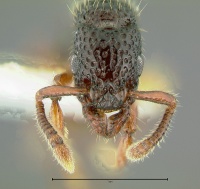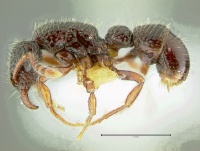Stictoponera chapmani
| Stictoponera chapmani | |
|---|---|

| |
| Scientific classification | |
| Kingdom: | Animalia |
| Phylum: | Arthropoda |
| Class: | Insecta |
| Order: | Hymenoptera |
| Family: | Formicidae |
| Subfamily: | Ectatomminae |
| Tribe: | Ectatommini |
| Genus: | Stictoponera |
| Species: | S. chapmani |
| Binomial name | |
| Stictoponera chapmani (Brown, 1958) | |
Stictoponera chapmani is relatively widespread but the number of specimens in collections is relatively meager.
Identification
Lattke (2004) - Head with straight, slightly convergent sides in frontal view; occipital lamella evenly convex in lateral view, lacking abrupt angles; posterior clypeal margin with lateral ridges enclosed by lateral foveolae, clypeal ridges converge posteriorly, running parallel briefly before meeting or fading on frons; petiolar node with broadly convex dorsal margin in lateral view. Also see the nomenclature section below.
Distribution
Known from Indonesia, Malaysia, Philippines and Thailand.
Latitudinal Distribution Pattern
Latitudinal Range: 10° to 10°.
| North Temperate |
North Subtropical |
Tropical | South Subtropical |
South Temperate |
- Source: AntMaps
Distribution based on Regional Taxon Lists
Indo-Australian Region: Borneo, Indonesia, Malaysia, Philippines (type locality).
Oriental Region: Thailand, Vietnam.
Distribution based on AntMaps
Distribution based on AntWeb specimens
Check data from AntWeb
Countries Occupied
| Number of countries occupied by this species based on AntWiki Regional Taxon Lists. In general, fewer countries occupied indicates a narrower range, while more countries indicates a more widespread species. |

|
Estimated Abundance
| Relative abundance based on number of AntMaps records per species (this species within the purple bar). Fewer records (to the left) indicates a less abundant/encountered species while more records (to the right) indicates more abundant/encountered species. |

|
Biology
Castes
Male unknown.
Worker
Images from AntWeb
   
| |
| Worker. Specimen code casent0179974. Photographer Erin Prado, uploaded by California Academy of Sciences. | Owned by MIZA, Maracay, Venezuela. |
Nomenclature
The following information is derived from Barry Bolton's Online Catalogue of the Ants of the World.
- chapmani. Gnamptogenys chapmani Brown, 1958g: 305, figs. 19, 44 (w.q.) PHILIPPINES (Negros I., Romblon I.).
- Type-material: holotype worker, 4 paratype workers.
- [Note: the paratypes dated 27.iv.1924, listed below, were removed from chapmani and transferred to leiolabia by Lattke, 2004: 189.]
- Type-locality: holotype Philippines: Negros Oriental, Cuernos Mts, nr Dumaguete, Camp Lookout (ca 600 m.), 19.iii.1924 (J.W. Chapman); paratypes: 2 workers with same data, 1 worker, 1 queen “at or near the type-locality”, 27.iv.1924 (J.W. Chapman), 2 workers Philippines: Romblon I., 5.iv.1924 (L. Morato).
- Type-depository: MCZC.
- [Note: Brown records the holotype (in fact all type-material) as being in MCZC, but Lattke, 2004: 187, places the holotype in USNM.]
- Combination in Stictoponera: Camacho, Franco, Branstetter, et al. 2022: 12.
- Status as species: Bolton, 1995b: 208; Lattke, 2004: 187 (redescription); Pfeiffer, et al. 2011: 35; Khachonpisitsak, et al. 2020: 37; Camacho, Franco, Branstetter, et al. 2022: 12.
- Distribution: Indonesia (Java), Malaysia (Peninsula, Sabah, Sarawak), Philippines (Negros, Romblon), Thailand.
Unless otherwise noted the text for the remainder of this section is reported from the publication that includes the original description.
Lattke (2004) - Brown (1958) described Stictoponera chapmani from specimens gathered in different localities. A study of the type material revealed that the worker and female taken on 27 April 1924 represent a different species (Stictoponera leiolabia) from the series of workers taken on 19 March 1924, which include the holotype of S. chapmani. Additional specimens mentioned by Brown (1958) from Romblon Island, Philippines, were not examined, but his discussion of intraspecific differences corresponds to differences between S. chapmani and S. leiolabia. The following characters described by Brown (1958) as intraspecific variation are actually attributes of S. leiolabia: narrower head (CI 0.70-0.76) and petiole, smaller and sparser foveolae, and the angular propodeal declivity relative to the mesosomal dorsum. Thus, the queen of S. chapmani described in Brown (1958) corresponds to S. leiolabia. The most easily discernible difference between the two species is the median clypeal area; in S. leiolabia it is mostly smooth down to the lamella, which is broadly concave, almost straight. This median area is bounded by two raised longitudinal crests that stretch from next to the anterior edge of each frontal lobe down to the lateral borders of the lamella.
Specimens vary in the degree of foveolate sculpturing, posteromedian clypeal sculpturing, the angle formed by the ventral and anterior pronotal margins in lateral view, the angle formed by the dorsal and declivitous propodeal margins in lateral view, the shape of the subpetiolar process, and size. When two character states were well defined in some specimens other characters always merged into a continuity, making separation arbitrary.
Description
Worker
Lattke (2004) - Metrics (n = 21): HL 0.60-0.84, HW 0.42-0.66, ML 0.23-0.39, SL 0.32-0.56, ED 0.12-0.19, WL 0.73-1.16 mm. CI 0.69-0.81, SI 0.75-0.88, MI 0.52-0.69, OI 0.25-0.35. Head with broadly convex subparallel sides in frontal view; frons ranging from densely foveolate to mostly smooth with irregular rows of foveolae that become denser and more regular laterally, fine median line sometimes impressed from posterior clypeal margin to mid eye height, frons usually mostly smooth; clypeus posteromedially smooth to longitudinally strigulose, strigulae extending onto lamella, posterior clypeal margin with lateral ridges enclosed by lateral foveolae, ridges converge posteriorly, running parallel briefly before fading on frons, or meeting; anterior margin of clypeal lamella mostly convex, with or without slight median convexity; occipital lamella convex, without abrupt angles in lateral view.
Pronotum laterally mostly smooth, usually with scattered punctae dorsally, low longitudinal strigulae or undulations may be present along posterior margin, anteroventral pronotal margins form blunt angle; mesopleuron mostly smooth with scattered punctae, mesopleural sculpture variably impressed; metapleuron mostly smooth and flat, with longitudinal strigulae posteroventrally; propodeum smooth or with low strigulae laterally plus variable amount of foveolae, dorsal and declivitous propodeal margins joined by sharply rounded convexity or blunt angle in lateral view. Dorsum of mesosoma and petiole mostly smooth, foveolae present laterally, sometimes strigulae present laterally; petiolar node foveolate in lateral view, dorsum mostly smooth; subpetiolar process variable, from subquadrate to forming rounded lobe or triangle; postpetiole tergite foveolate over smooth ground sculpture, each depression deeper anteriorly than posteriorly, and progressively smaller in diameter posterad; fourth abdominal tergite laterally with less punctae than postpetiole, some concentrated along posterior edge; fourth abdominal tergite smooth with scattered punctulae, brief strigulae sometimes present along posterior margin. Fore coxa mostly smooth with low transverse strigulae posterad. Dorsum of thorax and abdominal segments 1-4 with abundant erect to subdecumbent hairs. Body ferruginous brown to brown, legs and antennae lighter colored than body.
Queen
Lattke (2004) - Metrics (n = 2): HL 0.78, 0.66; HW 0.61, 0.51; ML 0.32, 0.28; SL 0.52, 0.41; ED 0.19, 0.20; WL 1.22, 0.99 mm. CI 0.77, 0.77; SI 0.86, 0.80; MI 0.53, 0.55; OI 0.31, 0.39. Mesosomal dorsum mostly smooth with sparse foveolae, foveolae on pronotum denser; mesoscutum with faint longitudinal undulations and brief longitudinal fine sulci; mesopleural suture well impressed with minute transverse crests; metapleuron mostly strigulose with small smooth area. Petiolar node with evenly convex dorsal margin in lateral view, curvature not as broad as in worker.
Type Material
Lattke (2004) - Holotype worker: Philippines, Negros Oriental, Cuernos Mountain (Chapman) (National Museum of Natural History) [Examined]. The altitude of the type locality is reported in Brown (1958) as 600m.
References
- Brown, W. L., Jr. 1958g. Contributions toward a reclassification of the Formicidae. II. Tribe Ectatommini (Hymenoptera). Bulletin of the Museum of Comparative Zoology 118: 173-362. (page 305, figs. 19, 44 worker, queen described)
- Camacho, G.P., Franco, W., Branstetter, M.G., Pie, M.R., Longino, J.T., Schultz, T.R., Feitosa, R.M. 2022. UCE phylogenomics resolves major relationships among Ectaheteromorph ants (Hymenoptera: Formicidae: Ectatomminae, Heteroponerinae): A new classification for the subfamilies and the description of a new genus. Insect Systematics and Diversity 6(1): 5; 1–20 (doi:10.1093/isd/ixab026).
- Khachonpisitsak, S., Yamane, S., Sriwichai, P., Jaitrong, W. 2020. An updated checklist of the ants of Thailand (Hymenoptera, Formicidae). ZooKeys 998, 1–182 (doi:10.3897/zookeys.998.54902).
- Lattke, J. E. 2004. A Taxonomic Revision and Phylogenetic Analysis of the Ant Genus Gnamptogenys Roger in Southeast Asia and Australasia (Hymenoptera: Formicidae: Ponerinae). University of California Publications in Entomology 122: 1-266 (page 187, fig. 51 worker, queen described)
References based on Global Ant Biodiversity Informatics
- Brown W. L., Jr. 1958. Contributions toward a reclassification of the Formicidae. II. Tribe Ectatommini (Hymenoptera). Bulletin of the Museum of Comparative Zoology 118: 173-362.
- Lattke J. E. 2004. A taxonomic revision and phylogenetic analysis of the ant genus Gnamptogenys Roger in Southeast Asia and Australasia (Hymenoptera: Formicidae: Ponerinae). University of California Publications in Entomology 122: 1-266.
- Lattke, J.E. 2004. A taxonomic revision and phylogenetic analysis of the ant Gnamptogenys Roger in Southeast Asia and Australasia (Hymenoptera: Formicidae: Ponerinae). University of California Publications in Entomology 122: 1-266
- Pfeiffer M.; Mezger, D.; Hosoishi, S.; Bakhtiar, E. Y.; Kohout, R. J. 2011. The Formicidae of Borneo (Insecta: Hymenoptera): a preliminary species list. Asian Myrmecology 4:9-58
- Zryanin V. A. 2011. An eco-faunistic review of ants (Hymenoptera: Formicidae). In: Structure and functions of soil communities of a monsoon tropical forest (Cat Tien National Park, southern Vietnam) / A.V. Tiunov (Editor). – M.: KMK Scientific Press. 2011. 277 р.101-124.


